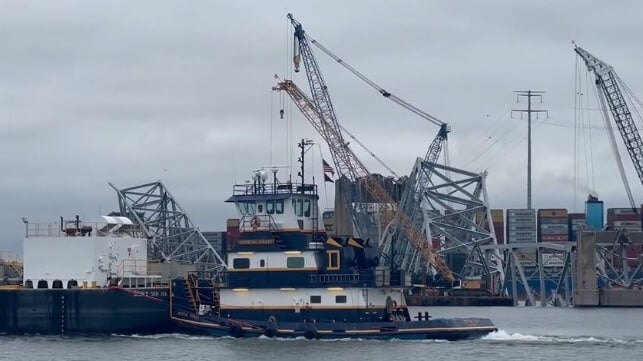First Tug Makes it Out of Baltimore Harbor After Bridge Collapse

The first commercial vessels to exit Baltimore's inner harbor after the collapse of the Francis Scott Key Bridge have made it safely through a temporary channel set up by the Army Corps of Engineers.
After careful surveys and a rapid deployment of channel marker buoys, two tug and barge transits took place Monday afternoon. The first one through was the tug Crystal Coast, bound for Dover Air Force Base with a barge full of jet fuel.
The channel - one of two new shallow-draft passages - will allow for the movement of salvage vessels between the two sides of the bridge's wreckage. The two temporary channels have depths of 11 and 14 feet, respectively, and a third channel with a 20-25 foot control depth is in the works as well.
"I'm thankful that only a week after the collapse, we have pathways and channels so commercial traffic can now move through," said Gov. Wes Moore at a press conference Tuesday.
In addition to the good news for tug and barge operators, ro/ro carriers are also seeing positive movement: Tradepoint Atlantic, the giant terminal complex at Sparrows Point, will be receiving a large number of extra ro/ro ships. The Port of Baltimore is America's busiest ro/ro port, and it appears set to keep much of its cargo volume despite the shutdown. Tradepoint Atlantic told the Baltimore Sun that it will be accepting nine extra ro/ro ships over the span of two weeks.
The Sparrows Point site is the port's only large cargo terminal located seaward of the Key Bridge, and its accessibility will also help the salvage effort. One of its multipurpose piers will be used to receive and recycle wrecked steel from the bridge.

that matters most
Get the latest maritime news delivered to your inbox daily.
The clearance of the main shipping channel is the unified command's primary objective, but it is a highly complex undertaking with an uncertain timeline. The wreckage of the main span is tangled up and partially buried in the mud on the bottom, making it harder for salvage engineers to plan for its removal.
In the long run, Baltimore will need a new bridge, and it is going to be expensive. It will likely be a much different structure with more redundancy built in, like a twin span cable-stayed bridge, according to civil engineering experts. Prof. Joseph L. Schofer of Northwestern University, a civil engineering expert, told Marketplace that the price tag in today's economy will probably come in somewhere in the range of $2-5 billion. Federal officials are predicting a similar price tag in the range of $2 billion, according to Roll Call. The original bridge cost $60 million in 1977, or roughly $360 million in current dollars. The project could take three to five years to complete.
